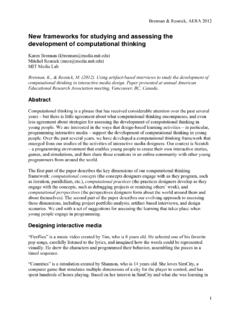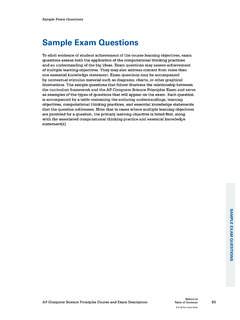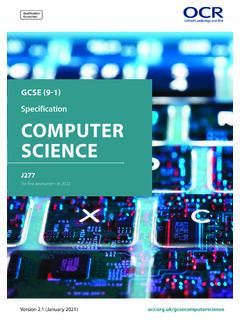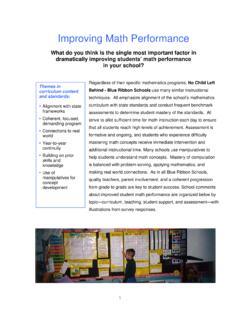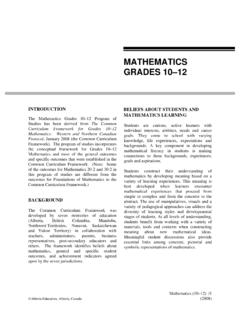Transcription of GCSE (9-1) Computer Science - Edexcel
1 GCSE (9-1) Computer ScienceSpecificationPearson Edexcel Level 1/Level 2 GCSE (9 - 1) in Computer Science (1CP2)First teaching September 2020 First certification 2022 Issue 1 ` Contents 1 Introduction 2 Why choose the Pearson Edexcel GCSE Computer Science 2020? 2 Supporting you in planning and implementing this qualification 3 Qualification at a glance 4 2 Subject content 6 Paper 1: Principles of Computer Science 7 Paper 2: Application of computational thinking 13 3 Assessment information 18 4 Administration and general information 19 Entries 19 Access arrangements, reasonable adjustments, special consideration and malpractice 20 Student recruitment and progression 23 Appendix 1: Command word taxonomy 27 Appendix 2: Flowchart symbols 29 Appendix 3: The context for the development of this qualification 30 Appendix 4: Codes 32 Pearson Edexcel Level 1/Level 2 GCSE (9-1) in Computer Science Specification Issue 1 January 2020 Pearson Education Limited 2020 2 1 Introduction Why choose the Pearson Edexcel GCSE Computer Science 2020?
2 An exciting, practical focus on real-life programming, developing skills relevant to the future. We have developed our GCSE Computer Science 2020 in collaboration with teachers and the Computer Science community to create an engaging qualification that equips students with the knowledge and practical skills to thrive in the fast-changing world of Computer Science . Our qualification provides a practical approach to developing computational skills. This includes innovative, practical onscreen assessment to ensure all students develop the computational skills they need for an exciting digital future beyond the classroom. Clear and simple structure Our qualification has a straightforward structure with six comprehensive topic areas, assessed through two externally-examined papers. One of these is a written paper focused on computational thinking , data, computers, networks, and issues and impact of computing in the world today. The other is a practical onscreen assessment, which focuses on the ability to analyse and solve problems by designing, writing, testing and refining programs.
3 The qualification s combination of written and practical elements balances theory and practical application, providing students with a rounded experience of Computer Science . Practical programming experience Our approach of assessing programming practically via our new onscreen assessment allows schools to choose which Integrated Development Environment (IDE) to use. This means that students will be able to build their practical skills and experience by programming in a familiar environment. Clear and accessible assessment for all The ramping in our papers means they have a gradual increase in difficulty, helping build confidence for students as they work through the questions. The papers' consistent assessment structure and straightforward mark schemes make expectations clear to both teachers and students. A full support package and expert advice Our comprehensive teaching and learning support is rich in purposeful activities designed to apply learning to the real world.
4 We provide extensive free and paid for teaching and learning support, designed to support all teachers delivering this qualification. To help you prepare for the practical onscreen assessment, we will provide a digital repository of programming activities. These will consist of exercises, downloadable data files, sample solutions and commentaries. You can use these programming activities to develop the necessary knowledge and skills. Our Computer Science Subject Advisor is Tim Brady, a former teacher who is available to offer you the support and advice you need every step of the way. Pearson Edexcel Level 1/Level 2 GCSE (9-1) in Computer Science Specification Issue 1 January 2020 Pearson Education Limited 2020 3 Supporting you in planning and implementing this qualification Planning Our Getting Started guide gives you an overview of our 2020 GCSE qualification to help you to get to grips with the changes to content and assessment, and to help you understand what these changes mean for you and your students.
5 We will give you an editable course planner and scheme of work, including an interactive scheme of work that you can adapt to suit your department. Teaching and learning There will be a range of free teaching and learning support to help you deliver this qualification, including: suggested resource lists lesson activities and solutions a student guide materials for your options evenings. Preparing for exams We will also provide a range of resources to help you prepare your students for the assessments, including marked exemplars of student work with examiner commentaries. ResultsPlus ResultsPlus provides the most detailed analysis available of your students exam performance. It can help you identify the topics and skills where further learning would benefit them. Access to Scripts Our Access to Scripts service allows you to view your students marked scripts online or download them in PDF format. Our Access to Script service: provides visibility and transparency of marking helps to inform post-results decisions for students and boost their confidence helps identify skills gaps, so you can tailor future teaching plans and refine approaches supports departmental CPD.
6 Get help and support Our Subject Advisor service and online community, led by Tim Brady, will ensure you receive help and guidance from us, and that you can share ideas and information with other teachers. You can sign up to receive e-newsletters from Tim to keep up to date with qualification updates and product and service news. Subject Advisor contact details UK: 0333 016 4160 International: +44 (0) 333 016 4160 Contact us at: Learn more at Pearson Edexcel Level 1/Level 2 GCSE (9-1) in Computer Science Specification Issue 1 January 2020 Pearson Education Limited 2020 4 Qualification at a glance Content and assessment overview The Pearson Edexcel Level 1/Level 2 GCSE (9 1) in Computer Science consists of two externally-examined papers. Paper 1 is a written examination and Paper 2 is a practical onscreen assessment. Paper 1: Principles of Computer Science (*Paper code: 1CP2/01) Written examination: 1 hour and 30 minutes 50% of the qualification 75 marks Content overview This paper will assess Topics 1 to 5.
7 Topic 1: computational thinking understanding of what algorithms are, what they are used for and how they work; ability to follow, amend and write algorithms; ability to construct truth tables. Topic 2: Data understanding of binary, data representation, data storage and compression. Topic 3: Computers understanding of hardware and software components of Computer systems and characteristics of programming languages. Topic 4: Networks understanding of Computer networks and network security. Topic 5: Issues and impact awareness of emerging trends in computing technologies, and the impact of computing on individuals, society and the environment, including ethical, legal and ownership issues. Assessment overview This paper consists of five compulsory questions, each one focused on one of the topic areas. The questions consist of multiple-choice, short-, medium- and extended-open-response, tabular and diagrammatic items. Pearson Edexcel Level 1/Level 2 GCSE (9-1) in Computer Science Specification Issue 1 January 2020 Pearson Education Limited 2020 5 Paper 2: Application of computational thinking (*Paper code: 1CP2/02) Onscreen examination: 2 hours 50% of the qualification 75 marks Content overview This paper will assess Topic 6: Problem solving with programming.
8 The main focus of this paper is: understanding what algorithms are, what they are used for and how they work in relation to creating programs understanding how to decompose and analyse problems ability to read, write, refine and evaluate programs. Assessment overview This practical paper requires students to design, write, test and refine programs in order to solve problems. Students will complete this assessment onscreen using their Integrated Development Environment (IDE) of choice. They will be provided with: coding files a hard copy of the question paper the Programming Language Subset (PLS) as an insert in the question paper and in electronic format. Students should then answer the questions onscreen using Python 3. This assessment consists of six compulsory questions. *See Appendix 4: Codes for a description of this code and all other codes relevant to this qualification. Pearson Edexcel Level 1/Level 2 GCSE (9-1) in Computer Science Specification Issue 1 January 2020 Pearson Education Limited 2020 6 2 Subject content Qualification aims and objectives The aims and objectives of this qualification are to enable students to: understand and apply the fundamental principles and concepts of Computer Science , including abstraction, decomposition, logic, algorithms, and data representation analyse problems in computational terms through practical experience of solving such problems, including designing, writing and debugging programs think creatively, innovatively, analytically, logically and critically understand the components that make up digital systems and how they communicate with one another and with other systems understand the impact of digital technology on wider society, including issues of privacy and cybersecurity apply mathematical skills relevant to Computer Science .
9 Pearson Edexcel Level 1/Level 2 GCSE (9-1) in Computer Science Specification Issue 1 January 2020 Pearson Education Limited 2020 7 Paper 1: Principles of Computer Science Overview In order to become proficient Computer scientists, it is essential that students have knowledge and understanding of the field s fundamental principles and concepts. Content Topic 1: computational thinking Students are expected to develop a set of computational thinking skills that enable them to design, implement and analyse algorithms for solving problems. Students are expected to be familiar with and use the Programming Language Subset (PLS) document provided on the GCSE in Computer Science section of our website. The flowchart symbols students are expected to be familiar with and use are shown in Appendix 2. Subject content Students should: Decomposition and abstraction understand the benefit of using decomposition and abstraction to model aspects of the real world and analyse, understand and solve problems understand the benefits of using subprograms Algorithms be able to follow and write algorithms (flowcharts, pseudocode*, program code) that use sequence, selection, repetition (count-controlled, condition-controlled) and iteration (over every item in a data structure), and input, processing and output to solve problems understand the need for and be able to follow and write algorithms that use variables and constants and one- and two-dimensional data structures (strings, records, arrays) understand the need for and be able to follow and write algorithms that use arithmetic operators (addition, subtraction, division, multiplication, modulus, integer division, exponentiation)
10 , relational operators (equal to, less than, greater than, not equal to, less than or equal to, greater than or equal to) and logical operators (AND, OR, NOT) be able to determine the correct output of an algorithm for a given set of data and use a trace table to determine what value a variable will hold at a given point in an algorithm understand types of errors that can occur in programs (syntax, logic, runtime) and be able to identify and correct logic errors in algorithms understand how standard algorithms (bubble sort, merge sort, linear search, binary search) work Pearson Edexcel Level 1/Level 2 GCSE (9-1) in Computer Science Specification Issue 1 January 2020 Pearson Education Limited 2020 8 Subject content Students should: be able to use logical reasoning and test data to evaluate an algorithm s fitness for purpose and efficiency (number of compares, number of passes through a loop, use of memory) Truth tables be able to apply logical operators (AND, OR, NOT) in truth tables with up to three inputs to solve problems *In this specification, the term pseudocode is used to denote an informal written description of a program.











